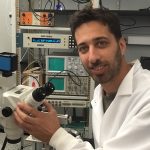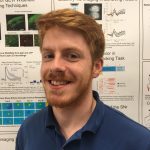Principal Investigator
Dr. Dieter Jaeger

Professor
Ph.D. in Neuroscience, University of Michigan, 1990
My interest is in neural coding, motor systems, and synaptic integration with a focus on basal ganglia and cerebellar systems. We like to combine neurophysiology with modeling approaches.
Office 2129
phone: (404) 727 8139
fax: (404) 727 2880
e-mail: djaeger -at- emory.edu
Lab Manager
Indeara (Indy) Martinez
 Lead Research Specialist
Lead Research Specialist
BA in Neuroscience, University of Pennsylvania, PA, 2015
BS Student (2nd year) in Mechatronics Engineering, Kennesaw State University
I am a neuroscientist and robotics engineering student. My research interests include neurophysiology, neural networking and modeling, and deep learning. My goal is to better understand the circuitries underlying movement control, because I am ultimately looking to create assistive devices and brain-computer interface technology for patients with motor dysfunction.
email: icogdel-at-emory.edu
PhD Researchers
Dr. Li, Su
 Senior Research Specialist
Senior Research Specialist
Ph.D. in Biophysics, Chinese Academy of Sciences, Beijing 2004
I do eletrophysioloy and fiber photometry in thalamus and motor cortex on mice performing running tasks, to better understand the neural basis of precise motor control.
e-mail: sli6 -at- emory.edu
Dr. Francesco Cavarretta
Post-doctoral Researcher
Ph.D. in Mathematics, Universita’ degli Studi di Milano, 2017
I use biophysically detailed modeling to investigate normal and parkinsonian dynamics in the basal ganglia – thalamo – cortical loop, with focus on the ventromedial thalamus.
e-mail: francesco.cavarretta -at- emory.edu
Dr. Aurélie Pala
 Associate Scientist
Associate Scientist
Ph.D. in Neuroscience, Swiss Federal Institute of Technology of Lausanne, 2014
I am interested in understanding the neuronal correlates of sensorimotor behaviors at a resolution ranging from individual neurons to neuronal circuits spreading across brain hemispheres. My current work investigates the role of distinct populations of cortical neurons in movement disorders characteristic of Parkinson’s disease using wide-field voltage imaging in mice performing locomotor and reaching behaviors.
e-mail: aurelie.pala -at- emory.edu
Yunmiao (Miao) Wang

Post-doctoral Researcher
Ph.D. in Neuroscience, Emory University, 2023
I am interested in the role of the basal-ganglia-thalamocortical circuits in decision making and motor control. My thesis work involves studying cortical dynamics during motor behaviors in mice using wide-field imaging.
e-mail: yunmiao.wang -at- emory.edu
Graduate Students
Taylor Kahl
Neuroscience PhD Student
MS in Neuroscience, Georgia State University, 2018
I’m a computational neuroscientist specializing in biophysically detailed neuronal modeling. My research interests are in understanding movement control, movement disorders, and movement rehabilitation. Currently, I am modeling the activity of L5b pyramidal neurons in motor cortex during movement execution, and analyzing how these neurons integrate inputs from the motor thalamus and other movement-related areas, in normal and Parkinsonian conditions.
e-mail: tkahl -at- emory.edu
Lisa Meyer-Baese
Biomedical Engineering PhD Student
BS in Biomedical Engineering, Georgia Institute of Technology, 2020
As a biomedical engineer my work so far focuses on integrating functional magnetic resonance imaging and optical imaging to understand brain wide spontaneous neuronal activity.
e-mail: lisa.meyer-baese -at- emory.edu
Madison Cohen
Medical Student, PCOM Georgia
MS in Biomedical Science PCOM Georgia, 2021
My research interests lie in movement, movement related disorders, and the human machine interface. In the Jaeger lab, my work focuses on using optogenetic techniques in awake behaving mice to better understand the role of the cerebellum in movement and movement disorders. I am also an avid hiker and I love to go on long hikes with my dogs in my free time.
Undergraduate Students
Michael Bian
Undergraduate Research Fellow
BS Student (4th year) in Neurosciences and Behavioral Biology, Emory University
I’m very interested in how the motor thalamus integrates sensory information to guide movement initiation and direction selection. In the Jaeger Lab, I work with Dr. Li Su to investigate sensorimotor behavior of mice when performing a cued locomotion task.
e-mail: michael.bian -at- emory.edu
Ellie Jiayi He
Undergraduate Research Fellow
BS Student (3rd year) in Neurosciences and Behavioral Biology, Emory University
My research interests are in behavioral and cognitive neuroscience, specifically the association between sensory inputs and motor outputs, and the process of cognition. I am mainly assisting Miao Wang with mice training in the Jaeger lab.
e-mail: ellie.jiayi.he -at- emory.edu
Samme Xie
Undergraduate Research Fellow
BS Student (3rd year) in Biology and Physics, Emory University
Currently, I’m assisting Dr. Aurelie Pala to study the roles of specific projection cell types in the forelimb motor and premotor cortex in motor dysfunction using a mouse model with Parkinson disease. I’m interested in behavioral neurobiology and using computational methods to understand mice behaviors in normal and Parkinsonia states.
e-mail: samme.xie -at- emory.edu
Alumni
Joseph Song
Undergraduate Research Fellow
BS Student (4th year) in Chemistry, Emory University
I’m interested in learning how the basal ganglia regulate locomotion and limb movement in mice. My goal is to improve locomotion in Parkinsonian mice through DBS.
e-mail: joseph.song -at- emory.edu
Trent Yu
BS Student (4th year) in Neurosciences and Behavioral Biology, Emory University
My research interests lie in clinical and behavioral neuroscience. I work with Dr. Alfonso Delgado-Reyes to model behavior in mice with parkinsonian symptoms.
e-mail: trent.yu -at- emory.edu
Dr. Nupur Katyare
 Post-doctoral Researcher
Post-doctoral Researcher
Ph.D. in Neurophysiology, Indian Institute of Science, Bangalore 2019
The focus of my work so far has been on studying neuronal coding and I find it fascinating trying to understand their language by employing different means, mainly electrophysiology. I worked on cells in the Medial Entorhinal cortex using patch-clamp electrophysiology and dynamic clamp for my Ph.D. Currently, my work involves using multichannel chronic silicon electrodes for recording the activity of a population of neurons mainly from the thalamus of awake behaving mice. I like the computational aspect of neuroscience as well and love to work at the intersection of theory and experiments.
e-mail: nupur.katyare -at- emory.edu
Dr. Huo Lu
 Adjunct Associate Professor
Adjunct Associate Professor
Ph. D. in Anatomy, Pennsylvania State University, PA, State College 1998
- Neurophysiology study of cerebellar function
- Computational modeling at single neuronal and network level
- Electron Microscopic study of cerebellar cortex
- fMRI study in the cerebellar sensory information processing
- Cellular level neural imaging using voltage sensitive dyes
e-mail: lhuo -at- emory.ed
Brune Le Chatelier
Undergraduate Research Fellow
BS Student in Neuroscience and Behavioral Biology, University of St Andrews (Scotland) / exchange student at Emory University (USA)
My main interests are focused on gaining a better understanding of neurodegenerative diseases, particularly Parkinson’s disease. This year, I am assisting Miao Wang with her PhD project.
e-mail: brune.le.chatelier -at- emory.edu
Dr. Alfonso Delgado-Reyes
Visiting Scientist
I am a Biologist and a Physiologist interested in Motor Control in Movement Disorders, specifically, I have been working in the basal ganglia nuclei studying information flow within the striatum, the globus pallidus and in the cortico-striatal, striato-pallidal and pallido-thalamic circuits through electrical and chemical stimulation and inhibition, both, in normal animals and in animal models of Parkinson’s disease. Later trained as a Physician and Surgeon, I am looking to focus on assistive and remedial motor control brain-machine interfaces. I was a Neuroscience postdoc at Prof. Dieter Jaeger’s Lab (2000-2003) studying short-term synaptic plasticity at the substantia nigra in rat brain slices; now I am back to study the possibility to ameliorate Parkinsonism through modulation of the ongoing beta wave activity through a real-time closed-loop feedback system.
e-mail: alfonso.delgado-reyes -at- emory.ed
Dr. Sonya Dave
Associate Scientist
PhD in Molecular Physiology & Biophysics, Vanderbilt University, 2010
In Dr. Jaeger’s lab, I do thalamic and cortical single cell recordings (‘Patch-clamp electrophysiology’) in mouse brain slices. Specifically, we use a method called dynamic clamp to understand how single thalamic neurons respond to physiologically relevant signal that mimic signals received during behavior (walking, resting, reaching, etc). Moreover, how is that response altered in Parkinson’s disease models, such as the 6-OHDA dopamine depleted mouse? This project involves neuronal patch-clamp recording, intracranial stereotaxic injections, literature analysis, and computational biology. In other projects prior to joining Dr. Jaeger’s lab (in June 2020), I have done single cell recordings since 2002, to study many different neurological and non-neurological diseases and processes, at the level of ion channel biophysics, to single cells, to synapses. On a personal level, I enjoy hiking, biking, listening to country music, trying to learn to run long distance, and hanging by/rafting the Chattahoochee on a beautiful Atlanta summer day.
Jillian Recchio
Research Specialist
BS in Neuroscience, Indiana University Southeast, 2019
Dr. Julien Catanese

Post-Doctoral Researcher
PhD in Neuroscience, University Pierre et Marie Curie, College de France, Paris 2012
I’m interested in gaining a better understanding of the neuronal basis of motor decision making. The dysfunction of such brain mechanisms can generate cognitive and/or motor deficits, such as those observed in patients with Parkinson’s Disease. In order to correlate neuronal activity with behavior, I train mice in a decision making task and perform in vivo extracellular electrophysiology to record activity of distinct groups of neurons in different brain areas. Furthermore, I use an optogenetic technique to inhibit/excite a targeted brain region.
Dr. Arthur Morrissette
 Neuroscience PhD Student, PhD obtained 2018
Neuroscience PhD Student, PhD obtained 2018
BS in Biomedical Engineering, Georgia Institute of Technology, GA, Atlanta 2013
I am interested in how the basal ganglia influence thalamocortical activity to guide sensorimotor behavior. To do this I am utilizing cell-type specific optogenetic manipulations and cortical imaging in mice trained to perform complex motor tasks.
Abraham Chen
 Undergraduate Research Fellow
Undergraduate Research Fellow
BS Student in Quantitative Sciences, Emory University
I’m currently pursing a degree in quantitative sciences with a focus in biology. I work with Rhett Morrissette to investigate sensorimotor learning behavior in mice.
Chelsea Leversedge
 Undergraduate Research Fellow
Undergraduate Research Fellow
BS Student in Neurosciences and Behavioral Biology, Emory University
I’m very interested in behavioral neuroscience, specifically in movement planning and memory. I joined the Jaeger lab to learn about and practice behavioral training with mice under the supervision of Dr. Catanese. Our goal is to monitor the neuronal activity in the thalamus using electrophysiological recording during a licking task.
Porter Harrast
 Research Specialist
Research Specialist
BS in Neuroscience, Bates College, ME, Lewiston 2016.
Porter studied neuroscience, pre-modern history, and geology at Bates College. Hopes to enter graduate school studying for a PhD in movement neuroscience or neurobiology
Joel Lee
 Undergraduate Research Fellow
Undergraduate Research Fellow
BS in Neuroscience and Behavioral Biology, Emory University
As a student in the Jaeger Lab, his research focuses on the transmission of rate codes in cerebellar output pathways using computational models based on biophysical properties of neurons in the cerebellum.
Conrad Bhamani
 Undergraduate Summer Research Fellow
Undergraduate Summer Research Fellow
BS Student in Neuroscience and Behavioral Biology, Cornell University
In the Jaeger Lab, I trained transgenic mice in a behavioral experiment while they are stimulated optogenetically. My goal was to quantify how well they learned the task. To plot my result I learned to use Matlab.